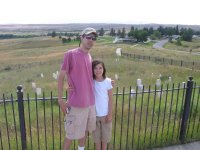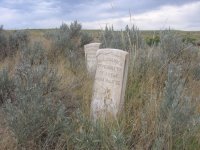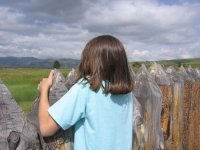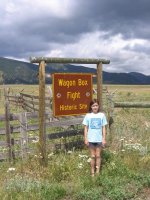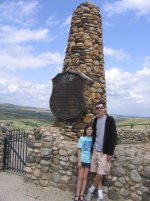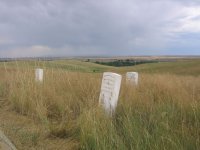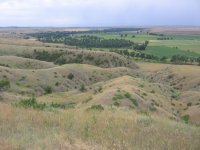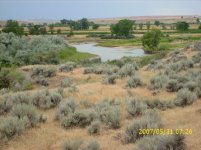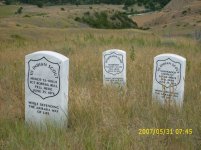Mister Dave
Command Sergeant Major
- Joined
- Dec 19, 2007
- Messages
- 2,037
I had the privilege this past week to travel out West with my fun-loving 10 year old daughter. The trip was partly an effort to spend some QT with little B. before what I hope is my last brief state-side tour of duty in support of OEF set to commence in a little over 2 weeks. Among the many classic sights taken in we had the good fortune to spend a mostly cloudy, windy day at Little Big Horn Battlefield National Monument and it was every bit as spooky as I'd remembered from my own childhood many years ago. The written accounts really do not convey the isolated feel of the place and also do not give a good sense of the breadth of the actual battlefield. Reno Hill is 5 loooooong miles from Last Stand Hill for example.
On the day following we had a most enjoyable visit to the site of Fort Phil Kearny about 19 miles SW of Sheridan, WY. The log fort constructed on the site in 1866 is gone, but some sections of the pallisade walls have been reconstructed and the site is walkable with former building sites marked and altogether gives a good idea of the place. There is an excellent museum and interpretive center on the site also. This was one of 3 outposts built to police the "Bloody Bozeman" trail leading to Montanna's gold fields from Fort Laramie between 1866 and 1868. Several significant incidents occurred in the fort's vicinity during this period, including the infamous Fetterman massacre on Dec. 21, 1866, in which Captain Fetterman led approximately 80 men from the post's cavalry and infantry garrison to their deaths at the hands of Cheyenne, Sioux, and Arapaho warriors waiting in ambush behind nearby Lodge Trail Ridge. The massacre site is marked with an impressive monument and the site of the action is partially walkable. The "Wagon Box Fight" occurred in August 1867 about 4 miles NW of the fort when a logging camp at nearby Piney Creek mostly defended by civilian wood-cutters and also by a small detachment of infantry from the fort successfully fended off a large party of attacking Indians by sheltering within a defensive circle of wagons. They were aided in this action by the arrival of newer breech loading weapons allowing much faster reloading and firing than the unfortunate souls with Captain Fetterman a year earlier.
It is amazing how drastically the landscape changes from lush green grass and cornfields to sage covered prairie the instant one crosses the Missouri River heading West across the vast expanse of mid SD. Very heady stuff, and little B. and I had a great adventure together to say the least. She has already RSVP'ed for next years excursion which will include Fort Laramie and the nearby Grattan Massacre site among other stops as yet to be determined.
MD
On the day following we had a most enjoyable visit to the site of Fort Phil Kearny about 19 miles SW of Sheridan, WY. The log fort constructed on the site in 1866 is gone, but some sections of the pallisade walls have been reconstructed and the site is walkable with former building sites marked and altogether gives a good idea of the place. There is an excellent museum and interpretive center on the site also. This was one of 3 outposts built to police the "Bloody Bozeman" trail leading to Montanna's gold fields from Fort Laramie between 1866 and 1868. Several significant incidents occurred in the fort's vicinity during this period, including the infamous Fetterman massacre on Dec. 21, 1866, in which Captain Fetterman led approximately 80 men from the post's cavalry and infantry garrison to their deaths at the hands of Cheyenne, Sioux, and Arapaho warriors waiting in ambush behind nearby Lodge Trail Ridge. The massacre site is marked with an impressive monument and the site of the action is partially walkable. The "Wagon Box Fight" occurred in August 1867 about 4 miles NW of the fort when a logging camp at nearby Piney Creek mostly defended by civilian wood-cutters and also by a small detachment of infantry from the fort successfully fended off a large party of attacking Indians by sheltering within a defensive circle of wagons. They were aided in this action by the arrival of newer breech loading weapons allowing much faster reloading and firing than the unfortunate souls with Captain Fetterman a year earlier.
It is amazing how drastically the landscape changes from lush green grass and cornfields to sage covered prairie the instant one crosses the Missouri River heading West across the vast expanse of mid SD. Very heady stuff, and little B. and I had a great adventure together to say the least. She has already RSVP'ed for next years excursion which will include Fort Laramie and the nearby Grattan Massacre site among other stops as yet to be determined.
MD


